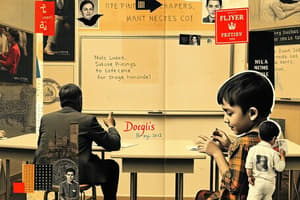Podcast
Questions and Answers
What is classroom management?
What is classroom management?
- A technique for classroom decoration
- A systematic designing of the classroom environment (correct)
- A form of student discipline
- A method for grading students
What is a key feature of a well-managed classroom?
What is a key feature of a well-managed classroom?
- No rules
- Student Choice, Growth and Empowerment (correct)
- Strict teacher control
- Isolation of students
What elements impact the effectiveness of instruction?
What elements impact the effectiveness of instruction?
Multidimensionality, Simultaneity, Immediacy, Unpredictability, Publicness, History
What are the 11 Guiding Principles of Classroom Management Procedures?
What are the 11 Guiding Principles of Classroom Management Procedures?
What is the most overlooked dimension in classroom management?
What is the most overlooked dimension in classroom management?
What does Psychosocial Dimension refer to?
What does Psychosocial Dimension refer to?
What factors determine classroom dynamics?
What factors determine classroom dynamics?
What is the Procedural Dimension?
What is the Procedural Dimension?
What is the role of classroom rules?
What is the role of classroom rules?
What are some tips for classroom procedures?
What are some tips for classroom procedures?
What does the Physical Dimension involve?
What does the Physical Dimension involve?
What should you remember in classroom arrangements?
What should you remember in classroom arrangements?
What does the Behavioral Dimension involve?
What does the Behavioral Dimension involve?
What is Positive Reinforcement?
What is Positive Reinforcement?
What must reinforcements be?
What must reinforcements be?
What is Negative Reinforcement?
What is Negative Reinforcement?
Give an example of Negative Reinforcement.
Give an example of Negative Reinforcement.
What is Extinction in behavioral management?
What is Extinction in behavioral management?
What is Contingency Contracting?
What is Contingency Contracting?
What is the Dependent Contingency Method?
What is the Dependent Contingency Method?
What is the Interdependent Contingency Method?
What is the Interdependent Contingency Method?
What are Natural Consequences?
What are Natural Consequences?
What is a Logical Consequence?
What is a Logical Consequence?
What is Punishment?
What is Punishment?
What are Reprimands?
What are Reprimands?
What is Response Cost?
What is Response Cost?
What are Time Outs?
What are Time Outs?
What is Self-Monitoring?
What is Self-Monitoring?
What is Self-Instruction?
What is Self-Instruction?
What are the different dimensions of classroom management?
What are the different dimensions of classroom management?
Study Notes
Classroom Management Overview
- Classroom management designs the environment to foster effective teaching and learning.
- A well-managed classroom encourages student choice, growth, and empowerment.
Key Elements Influencing Instruction
- Multidimensionality: Various activities occur simultaneously.
- Simultaneity: Multiple events happen at the same time.
- Immediacy: Instruction occurs at a rapid pace.
- Unpredictability: Unexpected changes influence dynamics.
- Publicness: Actions are observed by classmates.
- History: Past events shape current classroom interactions.
Guiding Principles of Classroom Management
- Every student is valued.
- Develop meaningful relationships.
- Foster a positive classroom climate.
- Maintain teacher control while planning ahead.
- Integrate student choice and diversity considerations.
- Adopt proactive over reactive approaches.
- Ensure consistency in management practices.
- Collaborate with colleagues and keep management strategies subtle.
Cultural Considerations
- Cultural diversity is often the most neglected aspect of effective classroom management.
Classroom Dynamics Factors
- Influence of students, teachers, peers, and family life on overall classroom dynamics.
Dimensions of Classroom Management
- Psychosocial: Addresses the psychological and social aspects affecting classroom interaction.
- Procedural: Involves established rules and procedures for classroom operation.
- Physical: Concerns the manipulable aspects of the physical classroom environment.
- Behavioral: Focuses on managing disruptive behaviors.
Effective Classroom Rules and Procedures
- Rules create expectations for behavior and contribute to a positive environment.
- Emphasize modeling procedures, simplicity, and positive over negative phrasing.
Classroom Arrangement Best Practices
- Ensure accessibility for all students, particularly those with behavioral challenges.
Reinforcement Techniques
- Positive Reinforcement: Introduces pleasant consequences to encourage desired behaviors.
- Reinforcements must be meaningful and presented immediately for maximum effectiveness.
- Negative Reinforcement: Removal of an adverse condition to encourage behavior continuation.
- Examples of negative reinforcement illustrate favorable outcomes.
Behavioral Management Strategies
- Extinction: Decrease behavior by ignoring or removing reinforcements.
- Contingency Contracting: Develop agreements with students for reinforcement based on behavior.
- Dependent Contingency: Group reward based on one member’s success.
- Interdependent Contingency: Entire group must meet goals for rewards.
- Natural Consequences: Use realistic consequences from students' environments.
- Logical Consequences: Expected outcomes from specific behaviors.
- Punishment: Introduce negative conditions or remove positives to deter behavior.
- Reprimands: Communicate inappropriate behaviors directly to students.
- Response Cost: Withdraw rewards for inappropriate behavior.
- Time Outs: Isolate students from reinforcement opportunities.
Self-Regulation Techniques
- Self-Monitoring: Students assess and record their own behaviors.
- Self-Instruction: Techniques that facilitate students teaching themselves.
Dimensions of Classroom Management
- Organizational, Instructional, Behavioral, Physical, Procedural, Psychosocial aspects contribute to effective classroom management.
Studying That Suits You
Use AI to generate personalized quizzes and flashcards to suit your learning preferences.
Description
Explore flashcards focusing on key concepts of classroom organization and management. This quiz covers essential terms and their definitions, helping educators understand effective teaching environments. Perfect for students studying educational techniques and classroom dynamics.




